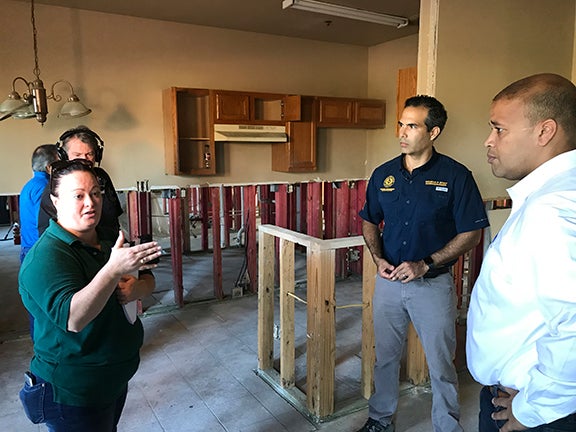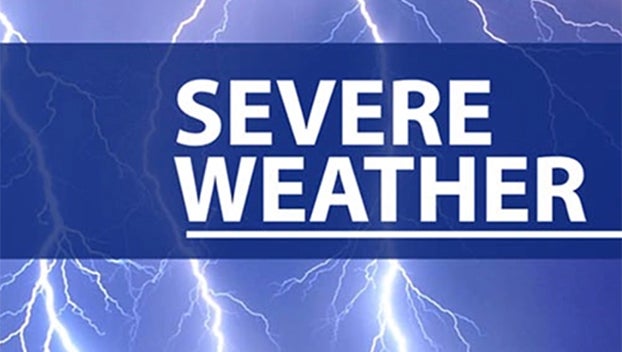Rigors of recovery: Residents struggle to repair damaged homes
Published 10:40 pm Friday, December 28, 2018

- GLO Spokeswoman Brittany Eck, left, speaks with Land Commissioner George P. Bushm center, and Mayor Derrick Freeman in a gutted first-floor apartment in Southwood Crossing last summer. (The News archive)
 Hurricane and Tropical Storm Harvey’s impact on Southeast Texas homeowners and renters was rapid and ruinous.
Hurricane and Tropical Storm Harvey’s impact on Southeast Texas homeowners and renters was rapid and ruinous.
Recovery for homeowners and residents of Greater Port Arthur — some 80 percent of the city was flooded — seemingly has come at a snail’s pace, even for those with private insurance but especially for those who weren’t insured or were inadequately insured. Some beleaguered residents who needed immediate assistance were still awaiting it at 2018’s close.
There are reasons for that. Damage was pervasive along the coastal counties. Some residents left the area, making headcounts and needs uncertain.
Available work crews, even for those who could afford their services, were too scarce. Myriad assistance programs had to be developed, each intended to meet needs of specific populations. Federal requests had to travel from the president to Congress and then through the federal bureaucracy before returning to Texas. Other deadly, destructive storms ravaged other parts of the U.S. during the year, making disaster funding here more problematic.
What happened for recovery over the course of the long 2018? A lot and not much.
Waiting on money
A lot happened in that federal money was approved, processes were instituted and applications extended. Not much, in that little money arrived quickly enough in Texas to directly help residents right away.
Here’s a timeline of residential recovery developments, in brief, taken from General Land Office reports:
• Harvey landfall came Aug. 25, 2017.
• Land Commissioner George P. Bush, the point man for federal disaster aid in Texas, made his initial request for help Aug. 29.
• President Trump OK’d an appropriations act in September to support response and recovery for disasters around the nation.
• On Feb. 9, Housing and Urban Development allocated $5.024 billion in aid to Texas.
• In April, the Department of Housing and Urban Development allocated for Texas $652,175,000 for additional, unmet housing needs and $4,074,456,000 for mitigation projects.
• GLO submitted a state action plan to HUD on May 8, which HUD approved June 25.
• The city of Houston and Harris County submitted plans to GLO in July.
• GLO published its state plan Sept. 7.
First, multi-families
In summer 2018, Bush announced in Port Arthur that GLO had allocated $45,980,638 in available disaster recovery funds for Texas to rehab, reconstruct and construct affordable, multi-family rental housing damaged by Harvey. Southwood Crossing Apartments, under the direction of Port Arthur’s housing authority, was allocated $13,322,460 for 204 units there, including all of the first-floor apartments, which were gutted. Another $3,728,273 went to Senior Citizens’ Y House of Beaumont, with 40 units.
Welcome as that help was, the actual program for construction at Southwood was not expected to be complete for a year. For those out of their homes, the wait got longer.
Homeowners got good news next: $205,019,250 of $1.1 billion for the Homeowner Assistance Program was designated for South East Texas — Jefferson, Orange and Hardin counties — for rehab, reconstruction, new construction, hazard mitigation, elevation and relocation assistance. The program would be carried out with state-approved builders and contractors. Locations were opened in each county where homeowners could apply for aid.
In Port Arthur, Mayor Derrick Freeman and the City Council approved spending $127,000 to prepare the 501 Building, where the Port Arthur Economic Development Corp. is located downtown, to house a “one-stop shop” where homeowners could apply for a portion of the available money with the assistance of qualified counselors. That shop opened Dec. 4 with the launch of the application process.
Here’s the down side: The need is much greater than available money. Most aid was targeted for low- and moderate-income people, leaving many working people marginalized.
And here’s a reminder for those who have not applied: Aid will be awarded first come, first served.
Port Acres visit
Bush revealed details of the Homeowner Assistance Program in November at the temporary trailer home of Havalisia Owens. She lives in a Federal Emergency Management Agency trailer next to the three-bed, one-bath home she inherited from her grandparents — located on the same 11/2-acre lot in Montrose Addition in Port Acres. A home health worker, she’s lived there all her life, in the home her grandfather built.
GLO representatives also told her the FEMA trailer — she had been scheduled to lose access to the trailer in February — could remain her home for an additional six months, a decision FEMA made on behalf of all Harvey residents in FEMA trailers.
GLO is also administering a program — $275 million in Community Development Block Grants are being used — in which local governments can effect buyouts or acquisitions of flood-prone properties that are routinely flooded during storms. Buyouts give the homeowners more money — pre-storm values for their homes — but put more burden on the governments, which must leave the property as open space, for recreation, floodplain or wetlands to reduce the risk of further flooding. Acquisitions, on the other hand, give the homeowners post-storm value for the land but enable governments to demolish flooded structures, mitigate the possibility of future disasters on the property, then possibly return the land to the tax rolls for further use. Port Arthur has opted for buyouts, which give property owners in affected areas more money; other governments are reviewing their options.
GLO will also administer a $100 million program through which homeowners who’ve made their home repairs might seek reimbursement of up to $50,000 per residence. Homeowners will be asked to, among other things, complete their receipts from their completed projects, certify the disaster assistance they’ve received and ensure the repairs were caused by Hurricane Harvey.
That program will begin as soon as January, a GLO spokesperson said.





